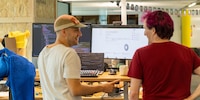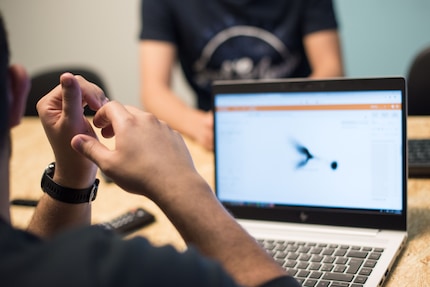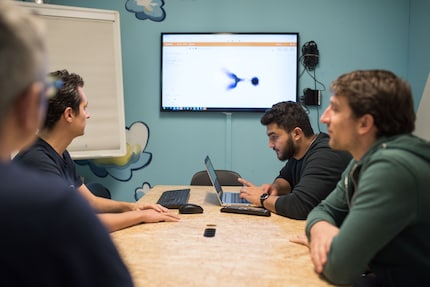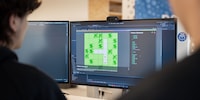
Behind the scenes
More AI, more price transparency – dispatches from Hackfest
by Martin Jungfer

It’s all the rage these days. Some people call it science fiction; others see it as a business revolution. What am I talking about? Artificial intelligence, of course. It’s even set to be introduced in the Digitec Galaxus AG warehouse. We looked at the example set out by the newly founded engineering team at Moonraker to find out more.
Until recently, artificial intelligence was a term reserved for experts but now it’s a common expression. Last week, the Swiss TV channel SRF honed in on the subject on their business programme ECO. Their discussion ranged from AI presenting a new opportunity for private enterprise to robot world dominance. What’s for sure is that machine learning has been an important topic at Digitec Galaxus AG for some time now. «Until quite recently, we were working together with the machine learning guild on artificial intelligence. It quickly became clear to us that we couldn’t make enough of a difference in a guild and that we needed our own independent engineering team,» explains Michael Hardegger, engineering team leader at Digitec Galaxus AG. «In the meantime, two machine learning engineers and two data specialists on the Moonraker team are tinkering about with clever algorithms.»
Artificial intelligence or AI for short is a branch of IT that deals with automating intelligent behaviour. Most artificial intelligence systems used today specialise in solving specific problems. This can be anything from understanding spoken language, diagnosing diseases, deciding legal verdicts and driving driverless cars. While finding solutions for these issues, AI often outperforms human experts. AI can even learn creativity – as computers have proven when they’ve written poems, painted pictures and composed music. The only arena where they can’t keep up with human brains is flexibility.
Thanks to machine learning algorithms, AI can learn patterns in training data and apply this knowledge to new data. «During training, we show AI input data and the output we want. This can take the form of product data delivered by suppliers (as an input) and the output could be the Digitec Galaxus AG product type that we assigned manually to the product afterwards,» explains Michael. «After the learning phase, AI can then assign new input data to the right product type independently. And if it doesn’t get it correct, it has to stay behind and try again.»

Just like pupils at school, artificial intelligence also has to sit an exam at the end of all this training. Only the best make the leap into productive systems. But even an optimised and tested AI can make mistakes, such as when it’s confronted with brand new data. «We might have taught AI to differentiate notebooks from nappies and mobile phones, but it could be stumped when it sees an Apple laptop as we’ve only shown it HP notebooks, for instance. It’s possible that AI would think Apple only produces mobile phones. And that’s when it would classify MacBooks as mobiles, which is obviously a mistake,» Michael clarifies. But just like people, AI never stops learning. Once the AI is corrected, it can use this correction as new training input and improve bit by bit.
Once Moonraker has made AI ready to use, the robots get started on work that people couldn’t do. One of these routine tasks is in our category management. Every day, new orders have to be made to replenish stock. It’s not a question of how low stock is; it’s about the demand that’s expected. A good example is raclette grills. It’s not a big deal when there aren’t many raclette grills on the shelves of the main warehouse in Wohlen in March. But it’s a different story in September when we need to have enough grills in stock for the growing demand in autumn. Michael is convinced algorithms can help ease the burden on category management: «AI learns seasonal trajectories and recognises other relationships between product characteristics and demand based on past ordering patterns. By learning this kind of information, AI is best placed to calculate the right number of products to order.»

What does all of this mean in practice? Well, for one thing, AI can now take over simple, boring tasks so that people can concentrate on the interesting, creative ones. That being said, human intelligence is needed in the first place to be able to control and train AI. Human intelligence then uses the most valuable commodity of all, time, to develop new solutions for complicated cases. In essence, the recipe for success for all machine learning applications is efficient collaboration between artificial and human intelligence.
Incidentally, the Moonraker team are hiring. If you think you’re the machine learning engineer they need, click here to apply.
News aren’t enough for me – it’s the stories behind the news that capture my interest. Curiosity is my constant companion and the reason why I spend Saturday afternoons in my favourite café, eavesdropping on city stories while planning my next travel adventure and creating new event ideas. Zen meditation can wait.
News about features in our shop, information from marketing and logistics, and much more.
Show all
Behind the scenes
by Martin Jungfer

Behind the scenes
by Daniel Steiner

Behind the scenes
by Daniel Borchers